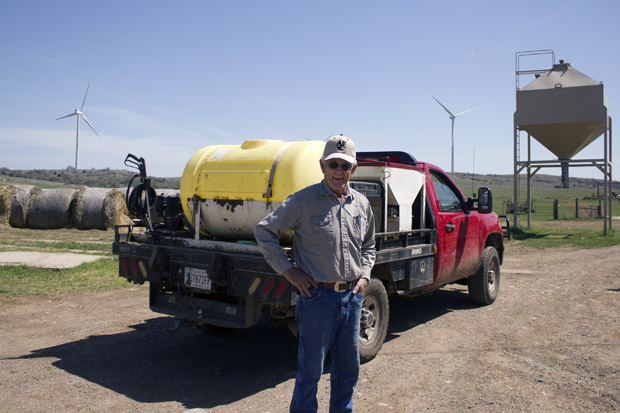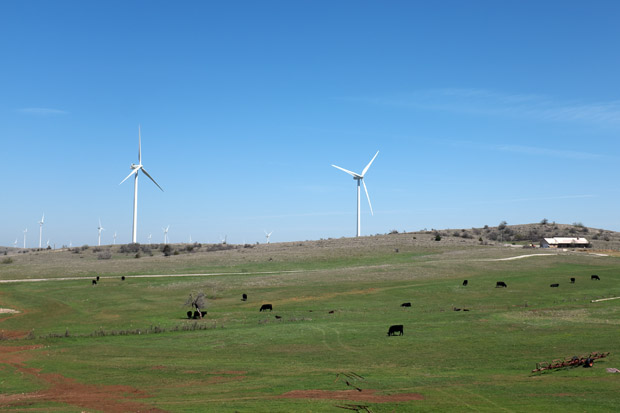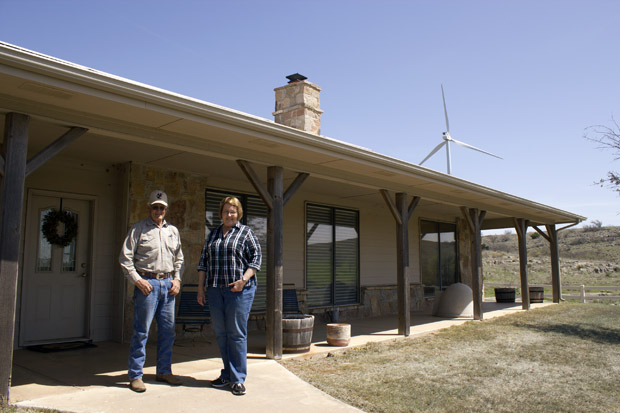
In Southwest Oklahoma, a Farmer Harvests the Wind and Watches the State Capitol
-
Joe Wertz

Joe Wertz / StateImpact Oklahoma
Bob Kerr on his ranch near Carnegie, Okla., which is flanked by turbines from the Blue Canyon Wind Farm.
Lawmakers have filed several measures targeting Oklahoma’s wind industry during the 2015 legislative session. The bills most likely to end up on the governor’s desk add regulation — like preventing new wind farms from being built near hospitals, schools and airports — and reduce wind energy tax credits.
Bob Kerr has lived on his Caddo County ranch for 43 years. The nearest tow, Carnegie, is home to about 1,700 people — a sprawling metropolis in southwestern Oklahoma
“When I first came here the only thing on this place was wagon tracks to a little frame house,” says 73-year-old Kerr. “ I’ve seen a lot of change.”
Spring has brought the heat, but not the rain.
Kerr steers his red pickup onto the road that divides his property and turns into a pasture. He’s tracking down a herd of cattle to make sure they’re drinking out of a water tank and a sludgy pond that’s shriveled and stagnated.
“That’s what’s left of our ponds,” he says. “They’re just gone.”
The Kerr’s seeded about 500 acres of wheat, which they’ll likely graze out to their 100 head of cattle due to the lack of rain. Five years of drought has plagued Oklahoma. Last year’s wheat harvest was a bust — Kerr harvested zero wheat in 2014, for the first time ever.
Beef prices are high, which is good for Kerr and other ranchers, but the cattle business can be as volatile as the oil business. Which has taken a nosedive in recent months. The wind business, however, is booming. Nationally, Oklahoma ranks No. 4 in wind power capacity — and Kerr couldn’t be happier.
“I feel like I won the lottery,” he says as he turns down a gravel road. Kerr jumps out of the truck and unlocks a squeaky, moaning gate. “Have you ever been up close to these things? They’re pretty impressive.”

Joe Wertz / StateImpact Oklahoma
The Blue Canyon Wind Farm and the Kerr family farm in southwest Oklahoma.
‘Windmills’ Don’t Eat
The Blue Canyon Wind Farm started operating more than a decade ago. Kerr leased land for five turbines; His wife’s family owns the neighboring ranch, which is home to 17. We drive around the turbines that dot a rocky outcropping above his house. For Kerr, life as a wind farmer is a lot easier than life as a traditional farmer. Turbines, he says, are less hassle than cattle.
“This is steady, dependable income, he says. “I don’t have to worry about feeding them, I don’t have to worry about breaking ice for them in the wintertime, I don’t have to worry about these windmills getting out on the road. It’s just a no worry deal. It’s been a very pleasant experience.”
The extra money from the wind leases has helped Kerr pay for a new barn. “ I’m building that barn because I can now because these windmills come help me along,” he says. “It’s kinda like a little extra retirement.”

Joe Wertz / StateImpact Oklahoma
Bob and Becky Kerr are big proponents of wind turbines, which overlook their home in southwest Oklahoma. Money from turbine leases has provided a stable source of income, they say helps offset their volatile farming and cattle business.
Inside the Kerr’s home, Bob and his wife Becky talk about life before turbine blades were spinning hundreds of feet overhead, and opposition voiced at the state Capitol.
Proposals for new wind farms have faced stiff resistance throughout the state. Residents worry about turbine safety, the sound of spinning blades and their effect on wildlife, and the flickering strobe light-like shadow the turbines can cast. Becky says the company that built Blue Canyon, now owned by EDP Renewables, helped minimize the nuisance by offering to install blinds or plant a row of trees to block the flicker.
“Trees grow slowly out here and it’s just something else to have to water, so we opted for the blinds,” Becky says.
Back in the truck, Bob Kerr says he’s made the 90-minute drive to Oklahoma City several times to speak at Corporation Commission hearings into possible new wind regulation, and to talk to lawmakers about wind energy legislation.
“If you make it too tough a climate in Oklahoma, they’ll go to Kansas or Texas or Colorado or somewhere,” he says. “I think they’re missing the boat.”
Even if tax credits are reduced and turbine locations are limited, the Blue Canyon wind farm would be grandfathered in. Whatever happens, Kerr hopes, in the future, the Oklahoma wind can help landowners — like him —make money if crops wither and oil wells run dry.
